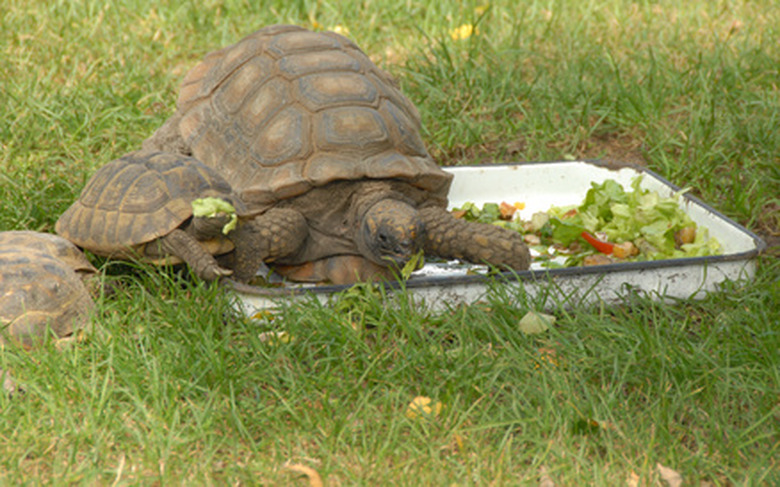Lawn Fertilizer And Sulcata Tortoises
The Sulcata tortoise is the second largest mainland tortoise, only to be surpassed by the Galapagos Island tortoises. Caught in the wild and raised as a pet, the tortoise is gaining popularity in captive breeding. The tortoise has a poor diet of mostly grass and hay, making feedings cheaper than many other family pets, but also raising concern about what kind of fertilizer to use and how often it should be applied.
Sulcata Tortoise
Sulcata, or "Spur-Thigh," tortoises are large-shelled tortoises that have a sandy shell and skin color. The adults develop sharp spikes in their front legs to assist them in digging and prevent them from being pulled out of their burrows. Mature Sulcata tortoises can be 2 to 2 ½ feet in length and weigh 100 to 200 pounds. Adult Sulcata tortoises are curious and interactive. Some may be aggressive toward each other, especially males, but given time they develop a hierarchy system. Although they may be aggressive toward each other, they are not aggressive toward people. Once a Sulcata becomes familiar with the keeper's feeding routine and sounds, it usually will walk up to him without hesitation.
- The Sulcata tortoise is the second largest mainland tortoise, only to be surpassed by the Galapagos Island tortoises.
- The tortoise has a poor diet of mostly grass and hay, making feedings cheaper than many other family pets, but also raising concern about what kind of fertilizer to use and how often it should be applied.
Natural Habitat
The Sulcata tortoise habitat ranges from parts of Africa to the Sub-Sahara desert, to the Red Sea and throughout the Sudan. The tortoise thrives in dry arid climates, digging holes to keep cool and to retain moisture. This large tortoise does not favor damp, wet or cool climates.
Lawn Fertilizer
The large Sulcata tortoises should be kept in an outdoor housing site. Because of their grassy diet, they usually will graze through a backyard lawn quickly. Avoid using fertilizers that are inorganic, this can cause the tortoise to become ill and can be fatal. Organic fertilizers should be used in moderation around tortoises. Remove the tortoise from the fertilized area the day the fertilizer is spread and a day afterward. Allow the excess fertilizer to absorb into the soil leaving only what the grass has absorbed available to the tortoise. Make sure the tortoise has grasses available that are fertilizer free in case it becomes sick or will not graze on the treated grass. When it is time to fertilize grass again, remove the tortoise from the area that will be treated and observe its behavior closely when returned. Try to avoid fertilizing as much as possible.
- The Sulcata tortoise habitat ranges from parts of Africa to the Sub-Sahara desert, to the Red Sea and throughout the Sudan.
- Remove the tortoise from the fertilized area the day the fertilizer is spread and a day afterward.
Captive Housing
When in captivity the Sulcata needs to have adequate lighting. If kept outdoors, make sure the area has direct sunlight and shade for cooling. Sulcata tortoises kept indoors should have UVB lighting for 14 hours per day, vitamin D3 and possibly a calcium supplement, such as a cuttlebone. The tortoise should have a supply of clean water in a shallow bowl at all times. The tortoise should have the proper humidity levels to prevent its shell from becoming deformed or getting an infection. Keeping humidity levels between 45 and 99 percent is ideal. Tortoises enjoy climbing, therefore provide safe "furniture," such as rocks or wood, for them to climb over. Make sure the tortoise cannot become injured if it falls off the "furniture."
- When in captivity the Sulcata needs to have adequate lighting.
- Sulcata tortoises kept indoors should have UVB lighting for 14 hours per day, vitamin D3 and possibly a calcium supplement, such as a cuttlebone.
Diet
The Sulcata tortoise has a voracious appetite. A diet high in fiber and calcium and low in fat and protein is ideal. In nature the tortoise grazes similarly to cows, sheep and goats. In the desert the tortoise has a diet that is nutritionally poor, therefore, if it is offered a highly nutritious diet in captivity, it can actually develop deformities. Grass and hay are the closest resemblance to its natural diet.
